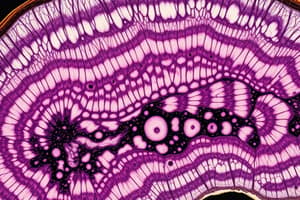Podcast
Questions and Answers
What does Cutting or Microtomy refer to?
What does Cutting or Microtomy refer to?
- Cutting processed tissue using a chainsaw
- Cutting processed tissue into thick slices
- Cutting processed tissue into uniformly thin slices (correct)
- Cutting processed tissue without using a knife
What is the size of tissue for routine histologic procedure?
What is the size of tissue for routine histologic procedure?
4-5u
What is the size of tissue for frozen sections (crstat)?
What is the size of tissue for frozen sections (crstat)?
10-15u
What is the size of tissue for electron microscopy?
What is the size of tissue for electron microscopy?
Who invented the Rocking Microtome?
Who invented the Rocking Microtome?
What is the most common type of microtome used today?
What is the most common type of microtome used today?
What is significant about the Sliding Microtome?
What is significant about the Sliding Microtome?
What is the function of a Base-sledge (Sliding Microtome)?
What is the function of a Base-sledge (Sliding Microtome)?
What is the difference in function between the Standard Sliding Microtome and the Base-sledge Microtome?
What is the difference in function between the Standard Sliding Microtome and the Base-sledge Microtome?
What is the Vibrotome used for?
What is the Vibrotome used for?
What type of knives does the Ultrathin Microtome use?
What type of knives does the Ultrathin Microtome use?
Who invented the Freezing Microtome?
Who invented the Freezing Microtome?
The clearance angle is ____ degrees.
The clearance angle is ____ degrees.
The bevel angle is ____ degrees.
The bevel angle is ____ degrees.
What size are routine work slides?
What size are routine work slides?
The water bath is maintained at ____C.
The water bath is maintained at ____C.
Flashcards are hidden until you start studying
Study Notes
Cutting or Microtomy
- Process of cutting processed tissue into uniformly thin slices for microscopic examination.
4-5u
- Size of tissue assessed for routine histologic procedures using a rotary microtome and a biconcave knife.
10-15u
- Size of unfixed tissue for frozen sections (cryostat) procedures.
0.5u
- Size specification for tissue samples intended for electron microscopy.
Rocking Microtome - Cambridge Rocking Microtome
- Considered the simplest microtome type.
- Difficult to re-orient the tissue block.
- Invented by Paldwell Trefall in 1881.
Rotary/Minot Microtome
- Most frequently used type for paraffin-embedded tissues.
- Developed by Minot between 1885-1886.
Sliding Microtome
- Known as the most dangerous microtome type due to exposed, movable knife.
- Invented by Adams in 1789.
Base-sledge (Sliding Microtome)
- Suitable for various media types.
- Features a moving block holder and a stationary knife.
Standard Sliding Microtome
- Configuration where the block remains stationary while the knife moves.
Rotary Rocking Microtome
- Specific details not provided but known for its rotary action.
Vibrotome
- Used for sectioning unfixed, unfrozen specimens and enzyme demonstrations.
- Sections can disintegrate easily, presenting a disadvantage.
Ultrathin Microtome
- Designed for cutting ultra-thin sections suitable for electron microscopy.
- Utilizes diamond knives or broken plate glass; specimens are small, fixed in osmium tetroxide, and embedded in plastic.
Freezing Microtome
- Invented by Queckett in 1848, utilized for cutting frozen tissue samples.
0-15 degrees
- Represents the clearance angle in microtomy procedures.
27-32 degrees
- Designates the bevel angle used during tissue cutting.
76x25mm slides, 1.0-1.2 mm thick
- Standard slides used for routine work, known for their durability and resistance to breaking.
45-50C
- Temperature range for water baths used during tissue preparation.
Studying That Suits You
Use AI to generate personalized quizzes and flashcards to suit your learning preferences.




